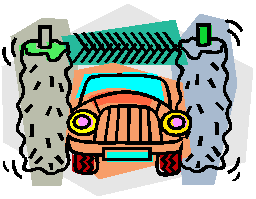 |
Automobile washing activities have the potential to contribute to storm drain pollutant loads because road dust washed from vehicles may contain metals and hydrocarbons. Any leaking fluids washed from the automobile may be carried to the storm drain by the wash water. Detergents used for automobile washing may contain phosphorus and foaming agents, which contribute to the eutrophication of receiving waterbodies. |
BEST MANAGEMENT PRACTICES (BMPs)
Take your vehicle to a commercial car wash whenever possible. If you must wash your car at home, practice the following BMPs:
Vehicles should be washed over pervious surfaces such as lawns and gravel areas so that the wash water can infiltrate into the ground.
Remaining detergent solutions prepared for use in vehicle washing, but not used up in the process, should never be disposed of by emptying into a storm drain or ditch. In addition the solutions may not be disposed of in areas that could drain into a storm drain or ditch, such as streets, driveways, sidewalks, and patios. Dispose of the solution into a sink, toilet, or floor drain, or to a pervious surface.
Dispose of excess wash water into a sink or toilet, or onto a pervious surface allowing complete infiltration. DO NOT DUMP excess wash water into the storm drain or the street.
Do not use "hose off" engine degreasers, unless washwater is captured and disposed of properly.
Limit the use of detergents and/or other cleaners when washing.
Use preventative practices to keep vehicles clean, such as parking in a garage or carport or using a cover.
Choose soaps, cleaners, or detergents labeled "non-toxic", "phosphate free", or "biodegradable". Vegetable and citrus-based products are typically safest for the environment.
Use a controllable spray nozzle that automatically shuts off when unattended or make a conscious effort to turn off the water when not actively washing down automobile.
Establish neighborhood wash areas, where runoff is properly controlled and managed.
Divert runoff from automobile washing to a grassy surface large enough to contain and allow complete infiltration.
Use "dry" methods to degrease or clean especially dirty parts prior to "wet" washing and rinsing (e.g., remove grease or brake dust using towels).
Avoid acid-based wheel cleaners.
|